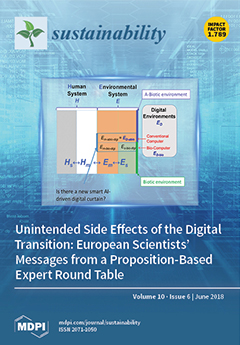1
Department Knowledge and Information Management, Danube University of Krems, 3500 Krems an der Donau, Austria
2
Department of Environmental Systems Sciences, ETH Zurich, 8092 Zurich, Switzerland
3
Department of Economics and Tinbergen Institute, Vrije Universiteit Amsterdam, 1081 HVAmsterdam, The Netherlands
4
Department of Psychology, LMU Munich, 80539 Munich, Germany
5
Department of Genetics, University of Groningen, University Medical Centre Groningen, 9700 CC Groningen, The Netherlands
6
Institute for Technology Assessment and Systems Analysis (ITAS), Karlsruhe Institute of Technology (KIT), 76131 Karlsruhe, Germany
7
Office of Technology Assessment at the German Bundestag (TAB), 10178 Berlin, Germany
8
Department of Humanities Social and Political Sciences ETH Zurich, 9092 Zurich, Switzerland
9
Hill & Associates, 1207 Geneva, Switzerland
10
Department of Informatics, University of Zurich, 8050 Zurich, Switzerland
11
Swiss Federal Laboratories for Materials Science and Technology (EMPA), 9014 St. Gallen, Switzerland
12
Division of Strategic Sustainable Studies, Department of Sustainable development, Environmental Science and Engineering, KTH Royal Institute of Technology, SE-10044 Stockholm, Sweden
13
Department of Molecular Psychology, Institute of Psychology and Education, Ulm University, 89069 Ulm, Germany
14
SCAN Laboratory, Clinical Hospital of the Chengdu Brain Science Institute and Key Laboratory for Neuroinformation, University of Electronic Science and Technology of China, Chengdu 611731, China
15
Center of Competence Public IT at Fraunhofer FOKUS, 10589 Berlin, Germany
16
Department for E-Governance and Administration, Danube University Krems, 3500 Krems an der Donau, Austria
17
Production Management Department, Laboratory for Machine Tools and Production Engineering (WZL), RWTH Aachen, 52056 Aachen, Germany
18
Institute for Advanced Sustainability Studies (IASS), 14467 Potsdam, Germany
19
International School of Management (ISM), 70180 Stuttgart, Germany
add
Show full affiliation list
remove
Hide full affiliation list
Abstract
We present the main messages of a European Expert Round Table (ERT) on the unintended side effects (
unseens) of the digital transition. Seventeen experts provided 42 propositions from ten different perspectives as input for the ERT. A full-day ERT deliberated communalities
[...] Read more.
We present the main messages of a European Expert Round Table (ERT) on the unintended side effects (
unseens) of the digital transition. Seventeen experts provided 42 propositions from ten different perspectives as input for the ERT. A full-day ERT deliberated communalities and relationships among these
unseens and provided suggestions on (i) what the major
unseens are; (ii) how rebound effects of digital transitioning may become the subject of overarching research; and (iii) what unseens should become subjects of transdisciplinary theory and practice processes for developing socially robust orientations. With respect to the latter, the experts suggested that the “ownership, economic value, use and access of data” and, related to this, algorithmic decision-making call for transdisciplinary processes that may provide guidelines for key stakeholder groups on how the responsible use of digital data can be developed. A cluster-based content analysis of the propositions, the discussion and inputs of the ERT, and a theoretical analysis of major changes to levels of human systems and the human–environment relationship resulted in the following greater picture: The digital transition calls for redefining economy, labor, democracy, and humanity. Artificial Intelligence (AI)-based machines may take over major domains of human labor, reorganize supply chains, induce platform economics, and reshape the participation of economic actors in the value chain. (Digital) Knowledge and data supplement capital, labor, and natural resources as major economic variables. Digital data and technologies lead to a post-fuel industry (post-) capitalism. Traditional democratic processes can be (intentionally or unintentionally) altered by digital technologies. The
unseens in this field call for special attention, research and management. Related to the conditions of ontogenetic and phylogenetic development (humanity), the ubiquitous, global, increasingly AI-shaped interlinkage of almost every human personal, social, and economic activity and the exposure to indirect, digital, artificial, fragmented, electronically mediated data affect behavioral, cognitive, psycho-neuro-endocrinological processes on the level of the individual and thus social relations (of groups and families) and culture, and thereby, the essential quality and character of the human being (i.e., humanity). The findings suggest a need for a new field of research, i.e., focusing on sustainable digital societies and environments, in which the identification, analysis, and management of vulnerabilities and
unseens emerging in the sociotechnical digital transition play an important role.
Full article





